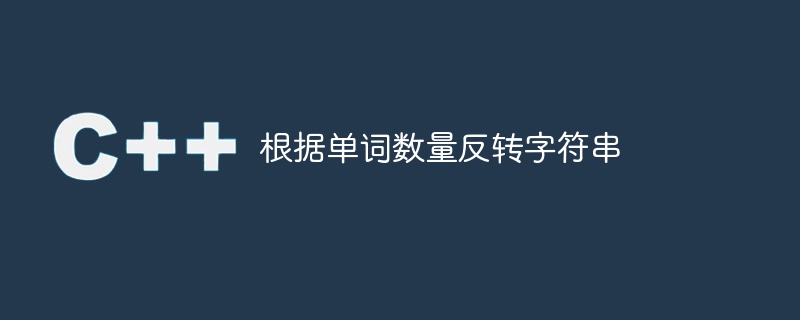Home >Backend Development >C++ >Reverse string according to number of words
Reverse string according to number of words
- WBOYWBOYWBOYWBOYWBOYWBOYWBOYWBOYWBOYWBOYWBOYWBOYWBforward
- 2023-09-03 15:09:061198browse

String manipulation is an essential skill in programming, as it helps us process and analyze text data efficiently. C provides a rich set of string manipulation functions and objects, making it easier to work with text data.
In this article, we will discuss how to reverse a string according to the number of words in C .
method
Approach 1 − Using stringstreams and vectors
Method 2 - Using substring and string manipulation functions
Syntax
String objects in C: The std::string class is part of the C standard library and provides various string manipulation functions.
String manipulation functions: Some common string manipulation functions in C include length(), substr(), find(), erase(), and replace().
std::string reverseStringByWords(const std::string& input) {}
std::reverse(words.begin(), words.end());
Approach 1:- Using stringstreams and vectors
This approach employed in the code involves converting the input string into a sequence of words using a stringstream object. The words are then extracted one by one from the stream and stored in a collection of strings represented by a vector.
Subsequently, the collection of words is reversed using the reverse function from the algorithm library. The reversed words are then joined together to form the final output string, with a space appended after each word except the last one.
algorithm
start
Get the input string.
Create a stringstream from the input string.
Initialize an empty vector to store words.
Extract words through stringstream iteration.
Extract a word from the stringstream.
Push the extracted word into the vector.
Reverse the vector containing the words.
Initialize an empty output string.
Form the output string by traversing the vector in reverse.
Add each word from the reversed vector to the output string, followed by a space.
Remove the last space from the output string.
Return the output string.
End
Example
The code embodies a procedure that inverts the sequence of words in a specified string. This is accomplished by first transforming the input string into a word-based stream through utilization of a stringstream object. Subsequently, the words are extracted one at a time and placed into a vector. Then, the reverse function from the algorithm library is employed to reverse the vector. Finally, the inverted words are joined together to form the conclusive output string, with spaces inserted after each word, excluding the final one. The last space is then deleted from the output string, rendering a compact and comprehensible solution that makes the most of Standard Library features like stringstreams, vectors, and the algorithm library.
#include <iostream>
#include <string>
#include <sstream>
#include <vector>
#include <algorithm>
std::string reverseStringByWords(const std::string& input) {
std::stringstream ss(input);
std::string word;
std::vector<std::string> words;
while (ss >> word) {
words.push_back(word);
}
std::reverse(words.begin(), words.end());
std::string output;
for (const auto& w : words) {
output += w + " ";
}
output.pop_back(); // Remove the last space
return output;
}
int main() {
std::string input = "Hello, how are you?";
std::string output = reverseStringByWords(input);
std::cout << "Input: " << input << std :: endl;
std:: cout << "Output: " << output << std :: endl;
return 0;
}
The Chinese translation of Output
is:Output
Input: Hello, how are you? Output: you? are how Hello,
Method 2: Using substring and string manipulation functions
Method 2 is another solution to reverse the order of words in the string. It uses substring and string manipulation functions instead of using string streams and vectors like in method 1.
This approach involves manually dividing the input string into substrings, which represent individual words. The substrings are concatenated in reverse order to form the final output string.
algorithm
start
Get the input string.
Initialize two size_t variables start and end, used to save the starting and ending positions of words in the input string.
Initialize the starting position to 0.
Find the position of the first space in the input string and store it in the end variable.
Initialize an empty output string.
Iterate through the input string and extract words using substrings.
Extract the substring from the starting position to the ending position.
Concatenate the extracted substring in front of the output string, followed by a space.
Update the start position to the position after the end position.
Find the next space in the input string starting from the new start position and update the end position.
After the loop ends, use
End
Example
The code is a solution for reversing the order of words in a given string. It does this by dividing the input string into substrings using the find function and concatenating these substrings in reverse order to form the output string. The last space character is then removed from the output string using the pop_back function. This approach is more manual and low-level compared to Approach 1 and requires a deeper understanding of string manipulation. The code takes a given input string, divides it into substrings, reverses the order of these substrings, and returns the final output string.
#include <iostream>
#include <string>
std::string reverseStringByWords(const std::string& input) {
size_t start = 0;
size_t end = input.find(' ');
std::string output;
while (end != std::string::npos) {
output = input.substr(start, end - start) + " " + output;
start = end + 1;
end = input.find(' ', start);
}
output = input.substr(start) + " " + output;
output.pop_back(); // Remove the last space
return output;
}
int main() {
std::string input = "Hello, how are you?";
std::string output = reverseStringByWords(input);
std::cout << "Input: " << input << std::endl;
std::cout << "Output: " << output << std::endl;
return 0;
}
Output
的中文翻译为:输出
Input: Hello, how are you? Output: you? are how Hello,
结论
在编程中字符串操作的重要性:掌握字符串操作技术对于任何程序员来说都是至关重要的,因为文本数据在软件开发中无处不在。理解各种字符串操作的方法可以帮助开发人员编写更高效、可维护和健壮的代码。
The above is the detailed content of Reverse string according to number of words. For more information, please follow other related articles on the PHP Chinese website!

